Udacity DeepRL project 1: Navigation - Part (2⁄3)
Using DQN to solve the Banana environment from ML-Agents
This is an Part-2 of an accompanying post for the submission of the Project 1: navigation from the Udacity Deep Reinforcement Learning Nanodegree, which consisted on building a DQN-based agent to navigate and collect bananas from the Banana Collector environment from Unity ML-Agents.

The following are the topics to be covered in this post:
4. DQN Implementation
At last, in this section we will cover the full implementation of the DQN algorithm from [2] that uses soft-updates. This implementation is based on the original DQN implementation from Deepmind (written in Torch and Lua), which can be found here. Our implementation tries to decouple the key aspects of the algorithm from the model itself in a kind of library-agnostic way (effectively decoupling the RL part from the DL part). At the end of this section we will add some considerations we made for our implementation.
Disclaimer: the trained model has not been tested in the Bnana-Visual environment, which provides as observations frames instead of the vector observations discussed earlier. There might be some code that is related to the visual case which I've been testing for a while, but I'm still debugging it. I'll update this post with the visual case as well once I have it working properly.
4.1 Interfaces and Concretions
Our implementation makes use of abstractions and decoupling, as we implemented the algorithm from scratch. The main reason is that we wanted to grasp extra details of the algorithm without following another implementation step by step (and also to avoid having a pile of tf.ops to deal with or some pytorch specific functionality laying around the core features of the algorithm 😄).
Just to be in the same page, by an Interface we mean a class that provides a blueprint for other classes to extend. These interfaces could have declarations of methods and data that their objects will use, but it does not implement them (at least most of them) and leaves some pure-virtual methods to be implemented by a child class. A Concretion is a specific class that extends the functionality of this interface, and it has to implement the pure-virtual methods. For example, our agent interface defines the functionality that is exposed by any agent along with some code that all concretions should have (like the actual steps of the DQN algorithm) but leaves some methods for the concrete agents, like the preprocess method which is case specific; and an agent concretion could be an agent that extends this functionality (and gains the common DQN implementation) but implements its own version of the preprocess step.
The interfaces and some of its concretions are listed below:
- Agent Interface, along concrete agents for BananaSimple, BananaVisual and Gridworld.
- Model Interface, along concrete models for Pytorch, Tensorflow or a numpy q-table.
- Memory Interface, along concrete buffers like ReplayBuffer and PriorityBuffer.
We wanted to make these interfaces as decoupled as possible from any Deep Learning package, which allowed us to test each component separately (we did not want to get into subtle bugs and poor performance due to specifics of the DL package). We specially made use of this feature when testing the core agent interface with a simple gridworld environment. This allowed us to find some bugs in our inplementation of the steps in the DQN algorithm that might have taken us more time if considering also the possibility that our DL model was buggy.
4.2 Agent Interface and Concretions
This interface has the implementation of the steps in the DQN algorithm, and has as components the model and memory in order to query them as needed. This is an "Abstract Class" in the sense that it shouldn't be instantiated. Instead, a specific class that inherits from this interface has to implement the preprocess method. Below we show this interface (only the methods, to give a sense of how this interface works), which can be found in the agent.py file in the dqn/core folder of the navigation package.
The key methods to be considered are the __init__, act, step, _preprocess and _learn methods, which implement most of the required steps of the DQN algorithm. We will discuss some of their details in snippets below, and we encourage the reader to look at the full implementation using the hyperlinks provided. Some might have some details removed (like dev. changes during testing), so they might look a bit different than the originals from the repo.
class IDqnAgent( object ) :
def __init__( self, agentConfig, modelConfig, modelBuilder, backendInitializer ) :
"""Constructs a generic Dqn agent, given configuration information
Args:
agentConfig (DqnAgentConfig) : config object with agent parameters
modelConfig (DqnModelConfig) : config object with model parameters
modelBuilder (function) : factory function to instantiate the model
backendInitializer (function) : function to be called to intialize specifics of each DL library
"""
###############################################
## IMPLEMENTATION HERE
###############################################
def save( self, filename ) :
"""Saves learned models into disk
Args:
filename (str) : filepath where we want to save the our model
"""
###############################################
## IMPLEMENTATION HERE
###############################################
def load( self, filename ) :
"""Loads a trained model from disk
Args:
filename (str) : filepath where we want to load our model from
"""
###############################################
## IMPLEMENTATION HERE
###############################################
def act( self, state, inference = False ) :
"""Returns an action to take from the given state
Args:
state (object) : state|observation coming from the simulator
inference (bool) : whether or not we are in inference mode
Returns:
int : action to take (assuming discrete actions space)
"""
###############################################
## IMPLEMENTATION HERE
###############################################
def step( self, transition ) :
"""Does one step of the learning algorithm, from Mnih et. al.
https://storage.googleapis.com/deepmind-media/dqn/DQNNaturePaper.pdf
"""
###############################################
## IMPLEMENTATION HERE
###############################################
def _preprocess( self, rawState ) :
"""Preprocess a raw state into an appropriate state representation
Args:
rawState (np.ndarray) : raw state to be transformed
Returns:
np.ndarray : preprocess state into the approrpiate representation
"""
raise NotImplementedError( 'IDqnAgent::_preprocess> virtual method' )
def _learn( self ) :
"""Makes a learning step using the DQN algorithm from Mnih et. al.
https://storage.googleapis.com/deepmind-media/dqn/DQNNaturePaper.pdf
"""
###############################################
## IMPLEMENTATION HERE
###############################################
@property
def epsilon( self ) :
return self._epsilon
@property
def seed( self ) :
return self._seed
@property
def learningMaxSteps( self ) :
return self._learningMaxSteps
@property
def actorModel( self ) :
return self._qmodel_actor
@property
def targetModel( self ) :
return self._qmodel_target
@property
def replayBuffer( self ) :
return self._rbuffer
- First we have the __init__ method, whose implementation is shown briefly in the snippet below. This is the constructor of our agent and is in charge of copying the hyperparameters from the passed configuration objects, create the models (action-value and target action-value networks), create the replay buffer (or a priority-based replay buffer if requested) and some other initialization stuff. We get around having to decouple the specific model creation code by passing a factory method that takes care of this.
def __init__( self, agentConfig, modelConfig, modelBuilder, backendInitializer ) :
"""Constructs a generic Dqn agent, given configuration information
Args:
agentConfig (DqnAgentConfig) : config object with agent parameters
modelConfig (DqnModelConfig) : config object with model parameters
modelBuilder (function) : factory function to instantiate the model
backendInitializer (function) : function to be called to intialize specifics of each DL library
"""
##################################
## COPY HYPERPARAMETERS ##
##################################
# seed numpy's random number generator
np.random.seed( self._seed )
# create the model accordingly
self._qmodel_actor = modelBuilder( 'actor_model', modelConfig, True )
self._qmodel_target = modelBuilder( 'target_model', modelConfig, False )
##################################
## INITIALIZE MODELS ##
##################################
# start the target model from the actor model
self._qmodel_target.clone( self._qmodel_actor, tau = 1.0 )
# create the replay buffer
if self._usePrioritizedExpReplay :
self._rbuffer = prioritybuffer.PriorityBuffer( self._replayBufferSize,
self._seed )
else :
self._rbuffer = replaybuffer.DqnReplayBuffer( self._replayBufferSize,
self._seed )
- The act method is in charge of deciding which action to take in a given state. This takes care of both the case of doing \( \epsilon \)-greedy during training, and taking only the greedy action during inference. Note that in order to take the greedy actions we query the action-value network with the appropriate state representation in order to get the Q-values required to apply the \( \argmax \) function
def act( self, state, inference = False ) :
"""Returns an action to take from the given state
Args:
state (object) : state|observation coming from the simulator
inference (bool) : whether or not we are in inference mode
Returns:
int : action to take (assuming discrete actions space)
"""
if inference or np.random.rand() > self._epsilon :
return np.argmax( self._qmodel_actor.eval( self._preprocess( state ) ) )
else :
return np.random.choice( self._nActions )
- The step method implements most of the control flow of the DQN algorithm like adding experience tuples to the replay buffer, doing training every few steps (given by a frequency hyperparameter), doing copies of weights (or soft-updates) to the target network every few steps, doing some book keeping of the states, and applying the schedule to \( \epsilon \) to control the ammount of exploration.
def step( self, transition ) :
"""Does one step of the learning algorithm, from Mnih et. al.
https://storage.googleapis.com/deepmind-media/dqn/DQNNaturePaper.pdf
"""
# grab information from this transition
_s, _a, _snext, _r, _done = transition
# preprocess the raw state
self._nextState = self._preprocess( _snext )
if self._currState is None :
self._currState = self._preprocess( _s ) # for first step
# store in replay buffer
self._rbuffer.add( self._currState, _a, self._nextState, _r, _done )
# check if can do a training step
if self._istep > self._learningStartsAt and \
self._istep % self._learningUpdateFreq == 0 and \
len( self._rbuffer ) >= self._minibatchSize :
self._learn()
# update the parameters of the target model (every update_target steps)
if self._istep > self._learningStartsAt and \
self._istep % self._learningUpdateTargetFreq == 0 :
self._qmodel_target.clone( self._qmodel_actor, tau = self._tau )
# save next state (where we currently are in the environment) as current
self._currState = self._nextState
# update the agent's step counter
self._istep += 1
# and the episode counter if we finished an episode, and ...
# the states as well (I had a bug here, becasue I didn't ...
# reset the states).
if _done :
self._iepisode += 1
self._currState = None
self._nextState = None
# check epsilon update schedule and update accordingly
if self._epsSchedule == 'linear' :
# update epsilon using linear schedule
_epsFactor = 1. - ( max( 0, self._istep - self._learningStartsAt ) / self._epsSteps )
_epsDelta = max( 0, ( self._epsStart - self._epsEnd ) * _epsFactor )
self._epsilon = self._epsEnd + _epsDelta
elif self._epsSchedule == 'geometric' :
if _done :
# update epsilon with a geometric decay given by a decay factor
_epsFactor = self._epsDecay if self._istep >= self._learningStartsAt else 1.0
self._epsilon = max( self._epsEnd, self._epsilon * _epsFactor )
- The _preprocess (as mentioned earlier) is a virtual method that has to be implemented by the actual concretions. It receives the observations from the simulator and returns the appropriate state representation to use. Some sample implementations for the BananaSimple-agent, BananaVisual-agent and Gridworld-agent are shown in the snippets that follow.
def _preprocess( self, rawState ) :
"""Preprocess a raw state into an appropriate state representation
Args:
rawState (np.ndarray) : raw state to be transformed
Returns:
np.ndarray : preprocess state into the approrpiate representation
"""
""" OVERRIDE this method with your specific preprocessing """
raise NotImplementedError( 'IDqnAgent::_preprocess> virtual method' )
###############################################
## Simple (just copy) preprocessing ##
###############################################
def _preprocess( self, rawState ) :
# rawState is a vector-observation, so just copy it
return rawState.copy()
###############################################
## One-hot encoding preprocessing ##
###############################################
def _preprocess( self, rawState ) :
# rawState is an index, so convert it to a one-hot representation
_stateOneHot = np.zeros( self._stateDim )
_stateOneHot[rawState] = 1.0
return _stateOneHot
################################################
## Stack 4 frames into vol. preprocessing ##
################################################
def _preprocess( self, rawState ) :
# if queue is empty, just repeat this rawState -------------------------
if len( self._frames ) < 1 :
for _ in range( 4 ) :
self._frames.append( rawState )
# ----------------------------------------------------------------------
# send this rawState to the queue
self._frames.append( rawState )
# grab the states to be preprocessed
_frames = list( self._frames )
if USE_GRAYSCALE :
# convert each frame into grayscale
_frames = [ 0.299 * rgb[0,...] + 0.587 * rgb[1,...] + 0.114 * rgb[2,...] \
for rgb in _frames ]
_frames = np.stack( _frames )
else :
_frames = np.concatenate( _frames )
return _frames
- The _learn method is the one in charge of doing the actual training. As explained in the algorithm we first sample a minibatch from the replay buffer, compute the TD-targets (in a vectorized way) and request a step of SGD using the just computed TD-targets and the experiences in the minibatch.
def _learn( self ) :
"""Makes a learning step using the DQN algorithm from Mnih et. al.
https://storage.googleapis.com/deepmind-media/dqn/DQNNaturePaper.pdf
"""
# get a minibatch from the replay buffer
_minibatch = self._rbuffer.sample( self._minibatchSize )
_states, _actions, _nextStates, _rewards, _dones = _minibatch
# compute targets using the target network in a "vectorized" way
_qtargets = _rewards + ( 1 - _dones ) * self._gamma * \
np.max( self._qmodel_target.eval( _nextStates ), 1 )
# casting to float32 (to avoid errors due different tensor types)
_qtargets = _qtargets.astype( np.float32 )
# make the learning call to the model (kind of like supervised setting)
self._qmodel_actor.train( _states, _actions, _qtargets )
- Finally, there are some specific concretions of this interface (as we mentioned earlier). We already showed the required implementation of the _preprocess method but, for completeness, you can find these concretions in the agent_raycast.py, agent_gridworld.py, and agent_visual.py.
4.3 Model Interface and Concretions
This interface abstracts away the required functionality that the agent interface needs from a model, regardless of the specific Deep Learning library used. Unlike the agent interface, which has some base code common to all agent types, this model interface has no common code implementation, apart from some getters (as you can see in the snippet below). The descriptions of all virtual methods that the backend-specific models have to implement are :
- build : build the architecture of the model (either using keras or torch.nn).
- eval : computes all q-values for a given state doing a forward pass.
- train : performs SGD (or some other optimizer) with the TD-targets as true q-values to fit.
- clone : implements soft-updates from another IDqnModel
class IDqnModel( object ) :
def __init__( self, name, modelConfig, trainable ) :
super( IDqnModel, self ).__init__()
##################################
## COPY CONFIGURATION DATA ##
##################################
def build( self ) :
raise NotImplementedError( 'IDqnModel::build> virtual method' )
def eval( self, state ) :
raise NotImplementedError( 'IDqnModel::eval> virtual method' )
def train( self, states, actions, targets ) :
raise NotImplementedError( 'IDqnModel::train> virtual method' )
def clone( self, other, tau = 1.0 ) :
raise NotImplementedError( 'IDqnModel::clone> virtual method' )
def save( self, filename ) :
raise NotImplementedError( 'IDqnModel::save> virtual method' )
def load( self, filename ) :
raise NotImplementedError( 'IDqnModel::load> virtual method' )
def initialize( self, args ) :
raise NotImplementedError( 'IDqnModel::initialize> virtual method' )
@property
def losses( self ) :
return self._losses
@property
def name( self ) :
return self._name
@property
def trainable( self ) :
return self._trainable
@property
def useImpSampling( self ) :
return self._useImpSampling
@property
def gradients( self ) :
return self._gradients
@property
def bellmanErrors( self ) :
return self._bellmanErrors
- The model_pytorch.py file contains a concrete implementation of the model interface using Pytorch as Deep Learning library. Below there is a snippet with most of the contents of this file. The DqnModelPytorch class serves as a proxy for the actual network implemented in a standard way using the torch.nn module and the torch.nn.Module class. Recall that the eval method is used for two purposes: computing the q-values for the action decision, and computing the q-targets for learning. We have to make sure this evaluation is not considered for gradients computations. We make use of torch.no_grad to ensure this requirement.We only have to compute gradients w.r.t. the weights of the action-value network \( Q_{\theta} \) during the training step, which is done automatically when the computation graph includes it for gradients computation when calling the network on the inputs \(\left \{ (s,a) \right \}\) from the minibatch (see train method).
class NetworkPytorchCustom( nn.Module ) :
def __init__( self, inputShape, outputShape, layersDefs ) :
super( NetworkPytorchCustom, self ).__init__()
# banana-raycast has a 37-vector as an observation (rank-1 tensor)
assert len( inputShape ) == 1, 'ERROR> input should be a rank-1 tensor'
# and also has a discrete set of actions, with a 4-vector for its qvalues
assert len( outputShape ) == 1, 'ERROR> output should be rank-1 tensor'
self._inputShape = inputShape
self._outputShape = outputShape
# define layers for this network
self.fc1 = nn.Linear( self._inputShape[0], 128 )
self.fc2 = nn.Linear( 128, 64 )
self.fc3 = nn.Linear( 64, 16 )
self.fc4 = nn.Linear( 16, self._outputShape[0] )
self.h1 = None
self.h2 = None
self.h3 = None
self.out = None
def forward( self, X ) :
self.h1 = F.relu( self.fc1( X ) )
self.h2 = F.relu( self.fc2( self.h1 ) )
self.h3 = F.relu( self.fc3( self.h2 ) )
self.out = self.fc4( self.h3 )
return self.out
def clone( self, other, tau ) :
for _thisParams, _otherParams in zip( self.parameters(), other.parameters() ) :
_thisParams.data.copy_( ( 1. - tau ) * _thisParams.data + ( tau ) * _otherParams.data )
class DqnModelPytorch( model.IDqnModel ) :
def __init__( self, name, modelConfig, trainable ) :
super( DqnModelPytorch, self ).__init__( name, modelConfig, trainable )
def build( self ) :
self._nnetwork = NetworkPytorchCustom( self._inputShape,
self._outputShape,
self._layersDefs )
def initialize( self, args ) :
# grab current pytorch device
self._device = args['device']
# send network to device
self._nnetwork.to( self._device )
# create train functionality if necessary
if self._trainable :
self._lossFcn = nn.MSELoss()
self._optimizer = optim.Adam( self._nnetwork.parameters(), lr = self._lr )
def eval( self, state, inference = False ) :
_xx = torch.from_numpy( state ).float().to( self._device )
self._nnetwork.eval()
with torch.no_grad() :
_qvalues = self._nnetwork( _xx ).cpu().data.numpy()
self._nnetwork.train()
return _qvalues
def train( self, states, actions, targets, impSampWeights = None ) :
if not self._trainable :
print( 'WARNING> tried training a non-trainable model' )
return None
_aa = torch.from_numpy( actions ).unsqueeze( 1 ).to( self._device )
_xx = torch.from_numpy( states ).float().to( self._device )
_yy = torch.from_numpy( targets ).float().unsqueeze( 1 ).to( self._device )
# reset the gradients buffer
self._optimizer.zero_grad()
# do forward pass to compute q-target predictions
_yyhat = self._nnetwork( _xx ).gather( 1, _aa )
# and compute loss and gradients
_loss = self._lossFcn( _yyhat, _yy )
_loss.backward()
# compute bellman errors (either for saving or for prioritized exp. replay)
with torch.no_grad() :
_absBellmanErrors = torch.abs( _yy - _yyhat ).cpu().numpy()
# run optimizer to update the weights
self._optimizer.step()
# grab loss for later saving
self._losses.append( _loss.item() )
return _absBellmanErrors
def clone( self, other, tau = 1.0 ) :
self._nnetwork.clone( other._nnetwork, tau )
def save( self, filename ) :
if self._nnetwork :
torch.save( self._nnetwork.state_dict(), filename )
def load( self, filename ) :
if self._nnetwork :
self._nnetwork.load_state_dict( torch.load( filename ) )
- The model_tensorflow.py file contains a concrete implementation of the model interface using Tensorflow as Deep Learning library. Below there is a snippet with most of the contents of this file. The DqnModelTensorflow class serves a container for the Tensorflow Ops created for the computation graph that implements the required evaluation and training steps. For the architecture, instead of creating tf ops for each layer, we decided to just use keras to create the required ops of the q-networks internally (see the createNetworkCustom function), and then build on top of them by creating other ops required for training and evaluation (see the build method). Because we are creating a static graph beforehand it makes it easier to see where we are going to have gradients being computed and used. If our model has its _trainable flag set to false we then just create the required ops for evaluation only (used for computing the TD-targets), whereas, if our model is trainable, we create the full computation graph which goes from inputs (minibatch \(\left \{ (s,a) \right \}\)) to the MSE loss using the estimates from the network and the TD-targets passed for training.
def createNetworkCustom( inputShape, outputShape, layersDefs ) :
# vector as an observation (rank-1 tensor)
assert len( inputShape ) == 1, 'ERROR> input should be a rank-1 tensor'
# and also discrete actions , with a 4-vector for its qvalues
assert len( outputShape ) == 1, 'ERROR> output should be rank-1 tensor'
# keep things simple (use keras for core model definition)
_networkOps = keras.Sequential()
# define initializers
_kernelInitializer = keras.initializers.glorot_normal( seed = 0 )
_biasInitializer = keras.initializers.Zeros()
# add the layers for our test-case
_networkOps.add( keras.layers.Dense( 128, activation = 'relu', input_shape = inputShape, kernel_initializer = _kernelInitializer, bias_initializer = _biasInitializer ) )
_networkOps.add( keras.layers.Dense( 64, activation = 'relu', kernel_initializer = _kernelInitializer, bias_initializer = _biasInitializer ) )
_networkOps.add( keras.layers.Dense( 16, activation = 'relu', kernel_initializer = _kernelInitializer, bias_initializer = _biasInitializer ) )
_networkOps.add( keras.layers.Dense( outputShape[0], kernel_initializer = _kernelInitializer, bias_initializer = _biasInitializer ) )
return _networkOps
class DqnModelTensorflow( model.IDqnModel ) :
def __init__( self, name, modelConfig, trainable ) :
super( DqnModelTensorflow, self ).__init__( name, modelConfig, trainable )
def build( self ) :
# placeholder for state inputs
self._tfStates = tf.placeholder( tf.float32, (None,) + self._inputShape )
# create the nnetwork model architecture
self._nnetwork = createNetworkCustom( self._inputShape,
self._outputShape,
self._layersDefs )
# create the ops for evaluating the output of the model (Q(s,:))
self._opQhat_s = self._nnetwork( self._tfStates )
# if trainable (action network), create the full resources
if self._trainable :
# placeholders: actions, act-indices (gather), and computed q-targets
self._tfActions = tf.placeholder( tf.int32, (None,) )
self._tfActionsIndices = tf.placeholder( tf.int32, (None,) )
self._tfQTargets = tf.placeholder( tf.float32, (None,) )
# @TODO|CHECK: Change the gather call by multiply + one-hot.
# Create the ops for getting the Q(s,a) for each batch of (states) + (actions) ...
# using tf.gather_nd, and expanding action indices with batch indices
self._opActionsWithIndices = tf.stack( [self._tfActionsIndices, self._tfActions], axis = 1 )
self._opQhat_sa = tf.gather_nd( self._opQhat_s, self._opActionsWithIndices )
# create ops for the loss function
self._opLoss = tf.losses.mean_squared_error( self._tfQTargets, self._opQhat_sa )
# create ops for the loss and optimizer
self._optimizer = tf.train.AdamOptimizer( learning_rate = self._lr )
self._opOptim = self._optimizer.minimize( self._opLoss, var_list = self._nnetwork.trainable_weights )
# tf.Session, passed by the backend-initializer
self._sess = None
def initialize( self, args ) :
# grab session and initialize
self._sess = args['session']
def eval( self, state, inference = False ) :
# unsqueeze if it's not a batch
_batchStates = [state] if state.ndim == 1 else state
_qvalues = self._sess.run( self._opQhat_s, feed_dict = { self._tfStates : _batchStates } )
return _qvalues
def train( self, states, actions, targets, impSampWeights = None ) :
if not self._trainable :
print( 'WARNING> tried training a non-trainable model' )
return None
# for gather functionality
_actionsIndices = np.arange( actions.shape[0] )
# dictionary to feed to placeholders
_feedDict = { self._tfStates : states,
self._tfActions : actions,
self._tfActionsIndices : _actionsIndices,
self._tfQTargets : targets }
# run the session
_, _loss = self._sess.run( [ self._opOptim, self._opLoss ], _feedDict )
# grab loss for later statistics
self._losses.append( _loss )
def clone( self, other, tau = 1.0 ) :
_srcWeights = self._nnetwork.get_weights()
_dstWeights = other._nnetwork.get_weights()
_weights = []
for i in range( len( _srcWeights ) ) :
_weights.append( ( 1. - tau ) * _srcWeights[i] + ( tau ) * _dstWeights[i] )
self._nnetwork.set_weights( _weights )
def save( self, filename ) :
self._nnetwork.save_weights( filename )
def load( self, filename ) :
self._nnetwork.load_weights( filename )
4.4 Memory Interface and Concretions
- The interface for the replay buffer is simpler than the others. Basically, we just need a buffer where to store experience tuples (add virtual method) and a way to sample a small batch of experience tuples (sample virtual method).
class IBuffer( object ) :
def __init__( self, bufferSize, randomSeed ) :
super( IBuffer, self ).__init__()
# capacity of the buffer
self._bufferSize = bufferSize
# seed for random number generator (either numpy's or python's)
self._randomSeed = randomSeed
def add( self, state, action, nextState, reward, endFlag ) :
"""Adds a transition tuple into memory
Args:
state (object) : state at timestep t
action (int) : action taken at timestep t
nextState (object) : state from timestep t+1
reward (float) : reward obtained from (state,action)
endFlag (bool) : whether or not nextState is terminal
"""
raise NotImplementedError( 'IBuffer::add> virtual method' )
def sample( self, batchSize ) :
"""Adds a transition tuple into memory
Args:
batchSize (int) : number of experience tuples to grab from memory
Returns:
list : a list of experience tuples
"""
raise NotImplementedError( 'IBuffer::sample> virtual method' )
def __len__( self ) :
raise NotImplementedError( 'IBuffer::__len__> virtual method' )
- The non-prioritized replay buffer (as in [2]) is implemented (snippet shown below) using a double ended queue (deque from python's collections module). We also implemented a prioritized replay buffer for Prioritized Experience Replay. This will be discussed in an improvements section later.
class DqnReplayBuffer( buffer.IBuffer ) :
def __init__( self, bufferSize, randomSeed ) :
super( DqnReplayBuffer, self ).__init__( bufferSize, randomSeed )
self._experience = namedtuple( 'Step',
field_names = [ 'state',
'action',
'reward',
'nextState',
'endFlag' ] )
self._memory = deque( maxlen = bufferSize )
# seed random generator (@TODO: What is the behav. with multi-agents?)
random.seed( randomSeed )
def add( self, state, action, nextState, reward, endFlag ) :
# create a experience object from the arguments
_expObj = self._experience( state, action, reward, nextState, endFlag )
# and add it to the deque memory
self._memory.append( _expObj )
def sample( self, batchSize ) :
# grab a batch from the deque memory
_expBatch = random.sample( self._memory, batchSize )
# stack each experience component along batch axis
_states = np.stack( [ _exp.state for _exp in _expBatch if _exp is not None ] )
_actions = np.stack( [ _exp.action for _exp in _expBatch if _exp is not None ] )
_rewards = np.stack( [ _exp.reward for _exp in _expBatch if _exp is not None ] )
_nextStates = np.stack( [ _exp.nextState for _exp in _expBatch if _exp is not None ] )
_endFlags = np.stack( [ _exp.endFlag for _exp in _expBatch if _exp is not None ] ).astype( np.uint8 )
return _states, _actions, _nextStates, _rewards, _endFlags
def __len__( self ) :
return len( self._memory )
4.6 Putting it all together
All the previously mentioned components are used via a single trainer, which is in charge of all functionality used for training and evaluation, like:
- Creating the environment to be studied.
- Implementing the RL loops for either training or testing.
- Loading and saving configuration files for different tests.
- Saving statistics from training for later analysis.
Below there's a full snippet of the trainer.py file that implements this functionality:
import os
import numpy as np
import argparse
import time
from tqdm import tqdm
from collections import deque
from collections import defaultdict
# imports from navigation package
from navigation import agent_raycast # agent for the raycast-based environment
from navigation import model_pytorch # pytorch-based model
from navigation import model_tensorflow # tensorflow-based model
from navigation.envs import mlagents # simple environment wrapper
from navigation.dqn.utils import config # config. functionality (load-save)
# logging functionality
import logger
from IPython.core.debugger import set_trace
TEST = True # global variable, set by the argparser
TIME_START = 0 # global variable, set in __main__
RESULTS_FOLDER = 'results' # global variable, where to place the results of training
SEED = 0 # global variable, set by argparser
CONFIG_AGENT = '' # global variable, set by argparser
CONFIG_MODEL = '' # global variable, set by argparser
USE_DOUBLE_DQN = False # global variable, set by argparser
USE_PRIORITIZED_EXPERIENCE_REPLAY = False # global variable, set by argparser
USE_DUELING_DQN = False # global variable, set by argparser
def train( env, agent, sessionId, savefile, resultsFilename, replayFilename ) :
MAX_EPISODES = agent.learningMaxSteps
MAX_STEPS_EPISODE = 1000
LOG_WINDOW_SIZE = 100
_progressbar = tqdm( range( 1, MAX_EPISODES + 1 ), desc = 'Training>', leave = True )
_maxAvgScore = -np.inf
_scores = []
_scoresAvgs = []
_scoresWindow = deque( maxlen = LOG_WINDOW_SIZE )
_stepsWindow = deque( maxlen = LOG_WINDOW_SIZE )
_timeStart = TIME_START
for iepisode in _progressbar :
_state = env.reset( training = True )
_score = 0
_nsteps = 0
while True :
# grab action from dqn agent: runs through model, e-greedy, etc.
_action = agent.act( _state, inference = False )
# apply action in simulator to get the transition
_snext, _reward, _done, _ = env.step( _action )
## env.render()
_transition = ( _state, _action, _snext, _reward, _done )
# send this transition back to the agent (to learn when he pleases)
## set_trace()
agent.step( _transition )
# prepare for next iteration
_state = _snext
_score += _reward
_nsteps += 1
if _done :
break
_scores.append( _score )
_scoresWindow.append( _score )
_stepsWindow.append( _nsteps )
if iepisode >= LOG_WINDOW_SIZE :
_avgScore = np.mean( _scoresWindow )
_avgSteps = np.mean( _stepsWindow )
_scoresAvgs.append( _avgScore )
if _avgScore > _maxAvgScore :
_maxAvgScore = _avgScore
# log resultss
if agent._usePrioritizedExpReplay :
_progressbar.set_description( 'Training> Max-Avg=%.2f, Curr-Avg=%.2f, Curr=%.2f, Eps=%.2f, Beta=%.2f' % (_maxAvgScore, _avgScore, _score, agent.epsilon, agent._rbuffer.beta ) )
else :
_progressbar.set_description( 'Training> Max-Avg=%.2f, Curr-Avg=%.2f, Curr=%.2f, Eps=%.2f' % (_maxAvgScore, _avgScore, _score, agent.epsilon ) )
_progressbar.refresh()
# save trained model
agent.save( savefile )
_timeStop = int( time.time() )
_trainingTime = _timeStop - _timeStart
# save training results for later visualization and analysis
logger.saveTrainingResults( resultsFilename,
sessionId,
_timeStart,
_scores,
_scoresAvgs,
agent.actorModel.losses,
agent.actorModel.bellmanErrors,
agent.actorModel.gradients )
# save replay batch for later visualization and analysis
_minibatch = agent.replayBuffer.sample( 100 )
_ss, _aa, _rr, _ssnext = _minibatch[0], _minibatch[1], _minibatch[2], _minibatch[3]
_q_s_batch = [ agent.actorModel.eval( agent._preprocess( state ) ) \
for state in _ss ]
_replayBatch = { 'states' : _ss, 'actions' : _aa, 'rewards' : _rr, 'nextStates' : _ssnext }
logger.saveReplayBatch( replayFilename,
sessionId,
TIME_START,
_replayBatch,
_q_s_batch )
def test( env, agent ) :
_progressbar = tqdm( range( 1, 10 + 1 ), desc = 'Testing>', leave = True )
for _ in _progressbar :
_state = env.reset( training = False )
_score = 0.0
_goodBananas = 0
_badBananas = 0
while True :
_action = agent.act( _state, inference = True )
_state, _reward, _done, _ = env.step( _action )
if _reward > 0 :
_goodBananas += 1
_progressbar.write( 'Got banana! :D. So far: %d' % _goodBananas )
elif _reward < 0 :
_badBananas += 1
_progressbar.write( 'Got bad banana :/. So far: %d' % _badBananas )
_score += _reward
if _done :
break
_progressbar.set_description( 'Testing> Score=%.2f' % ( _score ) )
_progressbar.refresh()
def experiment( sessionId,
library,
savefile,
resultsFilename,
replayFilename,
agentConfigFilename,
modelConfigFilename ) :
# grab factory-method for the model according to the library requested
_modelBuilder = model_pytorch.DqnModelBuilder if library == 'pytorch' \
else model_tensorflow.DqnModelBuilder
# grab initialization-method for the model according to the library requested
_backendInitializer = model_pytorch.BackendInitializer if library == 'pytorch' \
else model_tensorflow.BackendInitializer
# paths to the environment executables
_bananaExecPath = os.path.join( os.getcwd(), 'executables/Banana_Linux/Banana.x86_64' )
_bananaHeadlessExecPath = os.path.join( os.getcwd(), 'executables/Banana_Linux_NoVis/Banana.x86_64' )
if CONFIG_AGENT != '' :
agent_raycast.AGENT_CONFIG = config.DqnAgentConfig.load( CONFIG_AGENT )
if CONFIG_MODEL != '' :
agent_raycast.MODEL_CONFIG = config.DqnModelConfig.load( CONFIG_MODEL )
# instantiate the environment
_env = mlagents.createDiscreteActionsEnv( _bananaExecPath, seed = SEED )
# set the seed for the agent
agent_raycast.AGENT_CONFIG.seed = SEED
# set improvement flags
agent_raycast.AGENT_CONFIG.useDoubleDqn = USE_DOUBLE_DQN
agent_raycast.AGENT_CONFIG.usePrioritizedExpReplay = USE_PRIORITIZED_EXPERIENCE_REPLAY
agent_raycast.AGENT_CONFIG.useDuelingDqn = USE_DUELING_DQN
_agent = agent_raycast.CreateAgent( agent_raycast.AGENT_CONFIG,
agent_raycast.MODEL_CONFIG,
_modelBuilder,
_backendInitializer )
# save agent and model configurations
config.DqnAgentConfig.save( agent_raycast.AGENT_CONFIG, agentConfigFilename )
config.DqnModelConfig.save( agent_raycast.MODEL_CONFIG, modelConfigFilename )
if not TEST :
train( _env, _agent, sessionId, savefile, resultsFilename, replayFilename )
else :
_agent.load( _savefile )
test( _env, _agent )
if __name__ == '__main__' :
_parser = argparse.ArgumentParser()
_parser.add_argument( 'mode',
help = 'mode of execution (train|test)',
type = str,
choices = [ 'train', 'test' ] )
_parser.add_argument( '--library',
help = 'deep learning library to use (pytorch|tensorflow)',
type = str,
choices = [ 'pytorch','tensorflow' ],
default = 'pytorch' )
_parser.add_argument( '--sessionId',
help = 'identifier of this training run',
type = str,
default = 'banana_simple' )
_parser.add_argument( '--seed',
help = 'random seed for the environment and generators',
type = int,
default = 0 )
_parser.add_argument( '--visual',
help = 'whether or not use the visual-banana environment',
type = str,
default = 'false' )
_parser.add_argument( '--ddqn',
help = 'whether or not to use double dqn (true|false)',
type = str,
default = 'false' )
_parser.add_argument( '--prioritizedExpReplay',
help = 'whether or not to use prioritized experience replay (true|false)',
type = str,
default = 'false' )
_parser.add_argument( '--duelingDqn',
help = 'whether or not to use dueling dqn (true|false)',
type = str,
default = 'false' )
_parser.add_argument( '--configAgent',
help = 'configuration file for the agent (hyperparameters, etc.)',
type = str,
default = '' )
_parser.add_argument( '--configModel',
help = 'configuration file for the model (architecture, etc.)',
type = str,
default = '' )
_args = _parser.parse_args()
# whether or not we are in test mode
TEST = ( _args.mode == 'test' )
# the actual seed for the environment
SEED = _args.seed
# timestamp of the start of execution
TIME_START = int( time.time() )
_sessionfolder = os.path.join( RESULTS_FOLDER, _args.sessionId )
if not os.path.exists( _sessionfolder ) :
os.makedirs( _sessionfolder )
# file where to save the trained model
_savefile = _args.sessionId
_savefile += '_model_'
_savefile += _args.library
_savefile += ( '.pth' if _args.library == 'pytorch' else '.h5' )
_savefile = os.path.join( _sessionfolder, _savefile )
# file where to save the training results statistics
_resultsFilename = os.path.join( _sessionfolder,
_args.sessionId + '_results.pkl' )
# file where to save the replay information (for further extra analysis)
_replayFilename = os.path.join( _sessionfolder,
_args.sessionId + '_replay.pkl' )
# configuration files for this training session
_agentConfigFilename = os.path.join( _sessionfolder, _args.sessionId + '_agentconfig.json' )
_modelConfigFilename = os.path.join( _sessionfolder, _args.sessionId + '_modelconfig.json' )
# whether or not use the visual-banana environment
VISUAL = ( _args.visual.lower() == 'true' )
# DQN improvements options
USE_DOUBLE_DQN = ( _args.ddqn.lower() == 'true' )
USE_PRIORITIZED_EXPERIENCE_REPLAY = ( _args.prioritizedExpReplay.lower() == 'true' )
USE_DUELING_DQN = ( _args.duelingDqn.lower() == 'true' )
# Configuration files with training information (provided by the user)
CONFIG_AGENT = _args.configAgent
CONFIG_MODEL = _args.configModel
print( '#############################################################' )
print( '# #' )
print( '# Environment and agent setup #' )
print( '# #' )
print( '#############################################################' )
print( 'Mode : ', _args.mode )
print( 'Library : ', _args.library )
print( 'SessionId : ', _args.sessionId )
print( 'Savefile : ', _savefile )
print( 'ResultsFilename : ', _resultsFilename )
print( 'ReplayFilename : ', _replayFilename )
print( 'AgentConfigFilename : ', _agentConfigFilename )
print( 'ModelConfigFilename : ', _modelConfigFilename )
print( 'VisualBanana : ', _args.visual )
print( 'DoubleDqn : ', _args.ddqn )
print( 'PrioritizedExpReplay : ', _args.prioritizedExpReplay )
print( 'DuelingDqn : ', _args.duelingDqn )
print( 'Agent config file : ', 'None' if _args.configAgent == '' else _args.configAgent )
print( 'Model config file : ', 'None' if _args.configModel == '' else _args.configModel )
print( '#############################################################' )
experiment( _args.sessionId,
_args.library,
_savefile,
_resultsFilename,
_replayFilename,
_agentConfigFilename,
_modelConfigFilename )
This trainer came in handy when running various training sessions with different configurations for some ablation tests (we did not mention it, but the agent receives configuration objects that can be loaded and saved using .json files).
Finally, note that we developed a small wrapper on top of our ml-agents environment itself, in order to make it follow a more standard (and gym-like) way. Unity ml-agents has also an API for this, but as we are using an older version of the library we might had run into some issues, so we decided just to go with a simple env. wrapper and call it a day. Note that we also wanted to go for a standard gym-like API in order to reuse a simple Gridworld env. for testing purposes.
4.6 Considerations and tradeoffs
Why not directly couple everything?, isn't it faster?: Well, sections that could benefit from coupling would be sections that make heavy use of cpu-gpu transfers (kind of like passing constantly tensors between cpu and gpu, so it could be faster to just leave them in gpu). The only section so far that could benefit would be the TD-targets calculations, which does evaluation in data from minibatches from memory in the current device (either cpu or gpu) and then copies this data back to numpy ndarrays. We could actually write more ops (in tensorflow) for the whole TD-target calculation and training all in one pass, or avoid making copies from gpu to cpu from pytorch tensors, but the only part that would benefit would be the TD-targets transfer, which is a batch of vectors. Moreover, we wanted to make sure each piece of the DQN algorithm was working, so we wanted to be able to test each piece separately.
Why not place everything in a notebook?: Short answer: it's not my usual workflow. Long answer: I'd argue that doing it without notebooks can help you debug things easily, specially when you don't have all modules already completed. I've used jupyter notebooks for experiments and they're great for making experiments on top of already-made functionality and for showing results (in fact, some of the results are accesible through some notebooks in the repo), but for the full code I don't think they are the best option. Besides, I'd argue that debugging issues using pdb (or in more detail using code) is way easier and better than using a notebook (these tools really saved my day quite sometimes). I'd suggest you give it a try as well by running your scripts in debug mode, as shown below.
python -mpdb MY_AWESOME_FUNKY_SCRIPT.py <PARAMS>
5. Testing and choosing hyperparameters
In this section we discuss some of the steps we made in order to have a functional implementation that could solve the task at hand. We had many issues to get it working, so perhaps some of the steps we made could help you when making your own implementation.
5.1 Debugging and testing
Initially, our implementation was supposed to be working on gym environments that had a continuous state space and a discrete action space, being the environment suggested for testing gym's LunarLander. We had various bugs before we could have a working implementation of the DQN on this gym environment:
Crashes everywhere :
These issues where easier to fix. They where mostly due to our inexperience with the Deep learning package at hand. We decided to first implement the concrete model in PyTorch as we were already provided with a solution (by Udacity) that we could refer to in the worst case scenario. For this part, using pdb and running the scripts in debug mode helped a lot to debug shapes, arguments that some functions expected in some specific way (squeeze and unsqueeze here and there), etc.. PyTorch was a charm to work with because if something crashed we could just evaluate some tensors using pdb (or worst case using code). I'd suggest checking this post, which explains how to use pdb really well.
Simple test cases :
Once everything ran without crashes, and after various passes to the code to check that everything should work fine, we decided to let the beast loose and destroy the task. Well, that didn't go that well, as I only ended up destroying a virtual lunar lander every episode. There were some bugs in the code that I just didn't notice, even after various passes to the code. This is were having a decouple and modularized implementation came in handy.
You see, it's a bit frustrating when you look at your code and everything seems fine but it just doesn't work, and you actually have lots of places you can check and knobs you can tune. Where the errors due to my hyperparameters?. Was there an error that might have slipped all my checks?. Hopefully, I had watched a lecture from the DeepRL bootcamp in which John Schulman discussed the nuts and bolts of DeepRL. A suggestion that saved my day was to test in a simple toy problem and then to start to scale up to the problem at hand. So, I happened to have a gridworld environment laying around that I knew that tabular q-learning should solve.
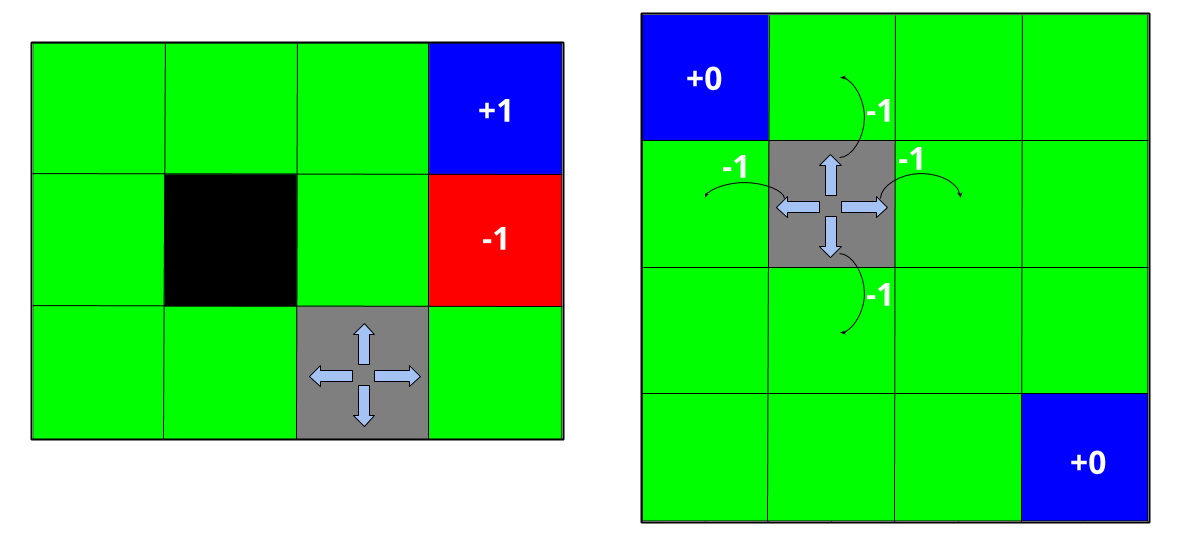
In order to make our DQN agent work in this simple gridworld we just had to modify the preprocess function such that each discrete state of the gridworld is converted into a one-hot encoding state-vector representation for our network, as shown in the following image.
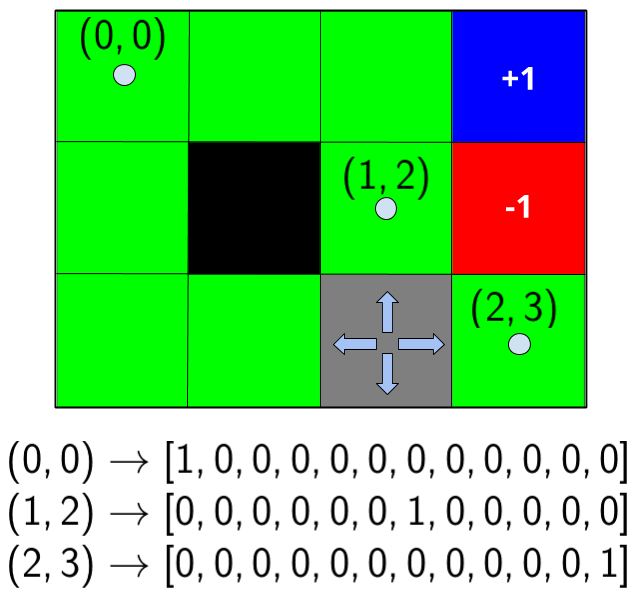
After fixing our implementation, this is what we obtained as the Q-table, constructed by evaluating the Q-network in the gridworld discrete states, which is what were expecting (what tabular q-learning also returned for the same configurations).
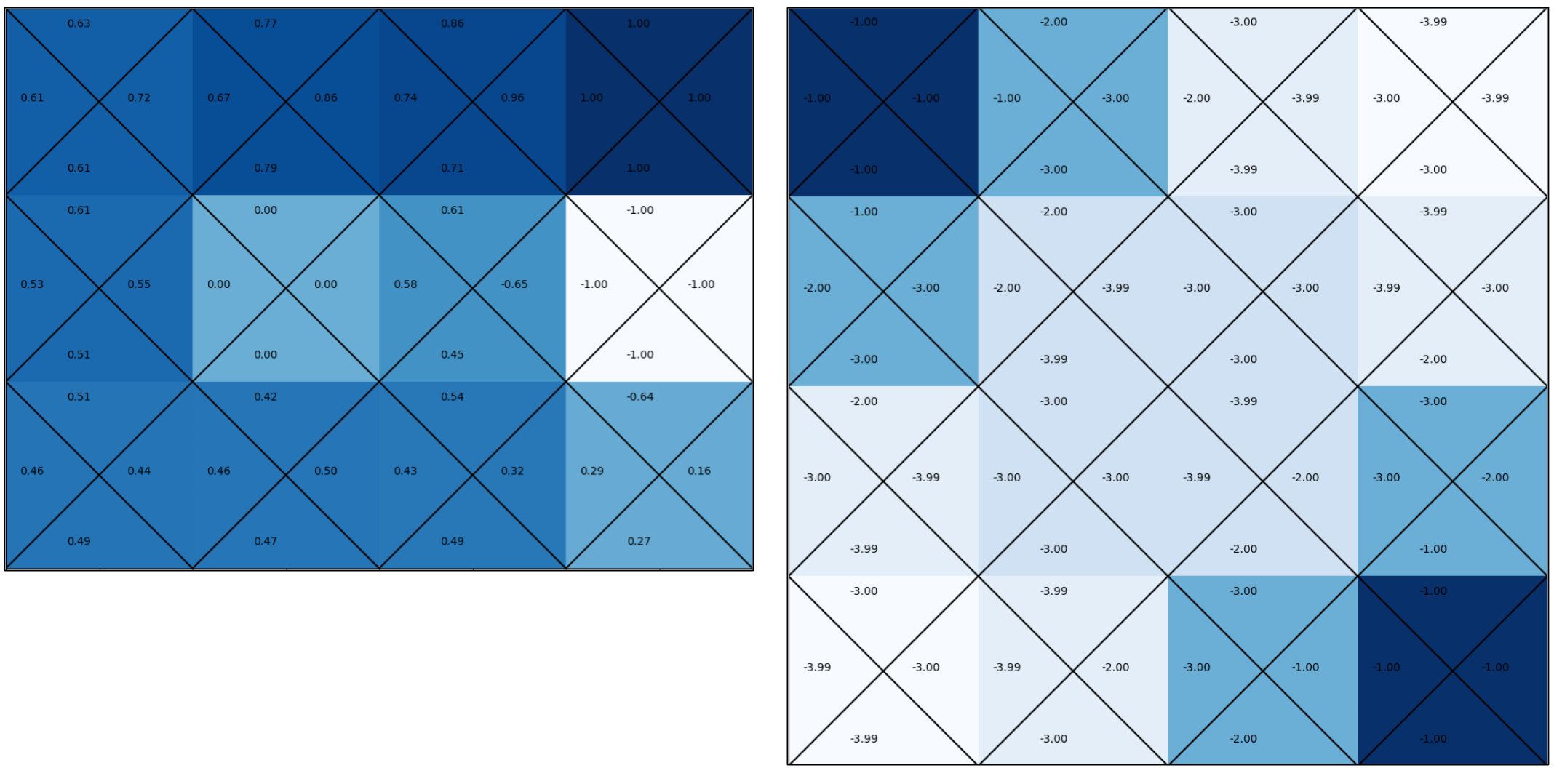
To train this, just use the trainer_full.py file (provided in the navigation package) as follows (for testing just replace "train" with "test" once training is complete):
# train a DQN-based agent with a MLP-model to solve gridworld
python trainer_full.py train --gridworld=true
# ... After training is completed
# test the trained model
python trainer_full.py test --gridworld=true
We then tried our implementation with some of the gym environments, specifically the Lunar Lander environment. Our implementation worked correctly on this environment after the fixes to the issues found using the gridworld test-case. The hyperparameters were set to roughly the same values found on the baseline of the Udacity DQN example. An example of the working agent is shown below:

To train this, just use the trainer_full.py as well in the following way (for testing just replace "train" with "test" once training is complete):
# train a DQN-based agent with a MLP-model to solve LunarLander-v2
python trainer_full.py train --gym=LunarLander-v2
# ... After training is completed
# test the trained model
python trainer_full.py test --gym=LunarLander-v2
Finally, we also tried to visualize the decision making process during runtime, so we made some simple visualization helpers to plot the Q-values for each action, and the V-value for each state (following the greedy policy).

5.2 Choosing hyperparameters
The hyperparameters were tuned from the starting hyperparameters of the DQN solution provided for the Lunar Lander. We didn't run exhaustive tests (neither grid nor random search) to tune the hyperparameters, but just incrementally increased/decreased some hyperparameters we considered important:
Replay Buffer size: too low of a replay buffer size (around \( 10^{4} \)) gave us poor performance even though we made various changes in the other hyperparameters to make it work. We then decided to gradually increase it until it could more or less solve the task, and finally set it at around \( 10^{5} \) in size.
Epsilon schedule: We exponentially decreased exploration via a decay factor applied at every end of episode, and keeping \( \epsilon \) fixed thereafter. Low exploration over all training steps led to poor performance, so we gradually increased it until we started getting good performance. The calculations we made to consider how much to increase were based on for how long would the exploration be active (until fixed at a certain value), how many training steps were available and how big was our replay buffer.
All other hyperparameters were kept roughly to the same values as the baseline provided by the DQN solution from Udacity, as based on these values they provided some initial training curves that showed that with their configuration we should be able to get good results.
The max. number of steps was kept fixed to the baseline value provided, as they showed that at max. 1800 steps a working solution should be able to already solve the task.
The learning rate and soft-updates factor was kept also the same as the baseline, as we consider these values to be small enough to not introduce instabilities during learning. We actually had an issue related to a wrong interpolation which made learning stable for test cases like lunar lander, but unstable for the banana environment. We were using as update rule \(\theta^{-} := \tau \theta^{-} + (1-\tau) \theta\), but the correct update rule was \(\theta^{-} := (1-\tau) \theta^{-} + \tau \theta\). As we were using a very small \(\tau\), we were effectively running our experiements with hard-updates at a very high frequency (1 update per 4 steps) instead of soft-updates. This seemed to be working fine for the Lunar Lander environment (we increased \(\tau\) to make it work), but didn't work at all in the banana environment.
The minibatch size was kept the same (64). As we are not using any big network nor using high dimensional inputs (like images) we don't actually have to worry much about our GPU being able to allocate resources for a bigger batch (so we could have set a bigger batch size), but we decided it to keep it that way. It would be interesting though to see the effect that the batch size has during learning. Of course, it'd take a bit longer to take a SGD step, but perhaps by taking a "smoother" gradient step we could get better/smoother learning.
The hyperparameters chosen for our submission (found in the config_submission.json file) are shown below:
"stateDim" : 37,
"nActions" : 4,
"epsilonStart" : 1.0,
"epsilonEnd" : 0.01,
"epsilonSteps" : -1,
"epsilonDecay" : 0.9975,
"epsilonSchedule" : "geometric",
"lr" : 0.0005,
"minibatchSize" : 64,
"learningStartsAt" : 0,
"learningUpdateFreq" : 4,
"learningUpdateTargetFreq" : 4,
"learningMaxSteps" : 2000,
"replayBufferSize" : 100000,
"discount" : 0.999,
"tau" : 0.001,
"seed" : 0,
"useDoubleDqn" : false,
"usePrioritizedExpReplay" : false,
"useDuelingDqn" : false
6. Results of DQN on the Banana Collector Environment
In this section we show the results of our submission, which were obtained through various runs and with various seeds. The results are presented in the form of time series plots each over a single run, and standard deviation plots over a set of similar runs. We will also show the results of one of three experiments we made with different configurations. This experiment did not include the improvements (DDQN, PER), which are going to be explained in a later section. The results can be found also in the results_analysis.ipynb. However, due to the size of the training sessions, we decided not to upload most of the results (apart from a single run for the submission) due to the file size of the combined training sessions. Still, to reproduce the same experiments just run the provided bash scripts:
- training_submission.sh : to run the base experiments for the submissions
- training_tests_1.sh : to run the first experiment, related to \( \epsilon \) tests
- training_tests_2.sh : to run the second experiment, related to how much the improvements (DDQN and PER) to DQN help.
- training_tests_3.sh : to run the third experiment, to check if our implementations of DDQN and PER actually helps in some setups with little exploration.
6.1 Results with the configuration for the submission
- Single runs: We choose one of the results of the various runs, plotted as time series plots. The x-axis represents episodes (during training) and the y-axis represents the score obtained at that episode. Also, the noisy blue plot is the actual score per episode, whereas the red curve is a smoothed (running average) curve from the previous one with a window of size 100. Below we show one random run from the episode (not cherry-picked) for both our pytorch and tensorflow implementations. As we can see, the agent successfully solves the environment at around episode 900. Note that this submission configuration is not the best configuration (hyperparameters tuned to squeeze the most score out of the environment), but a configuration we considered appropriate (moderate exploration). We found that for more aggressive exploration schedules (fast decay over around 300 episodes) and a moderate sized replay buffer the task could be solved in around 300 steps (see experiment 1 later).
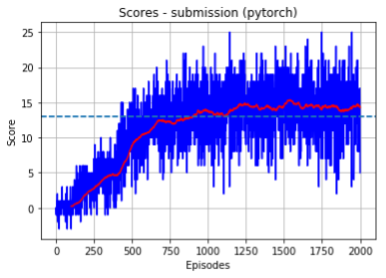
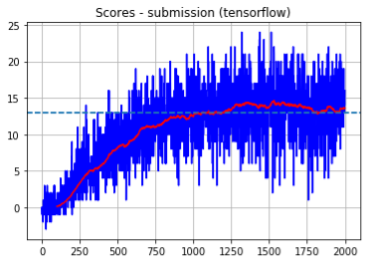
- All runs: Below we shows graphs of all runs in a single plot for three different random seeds. We again present one graph for each backend (pytorch and tensorflow). We recorded 5 training runs per seed. Recall again that all runs correspond to the same set of hyperparameters given by the config_submission.json file.
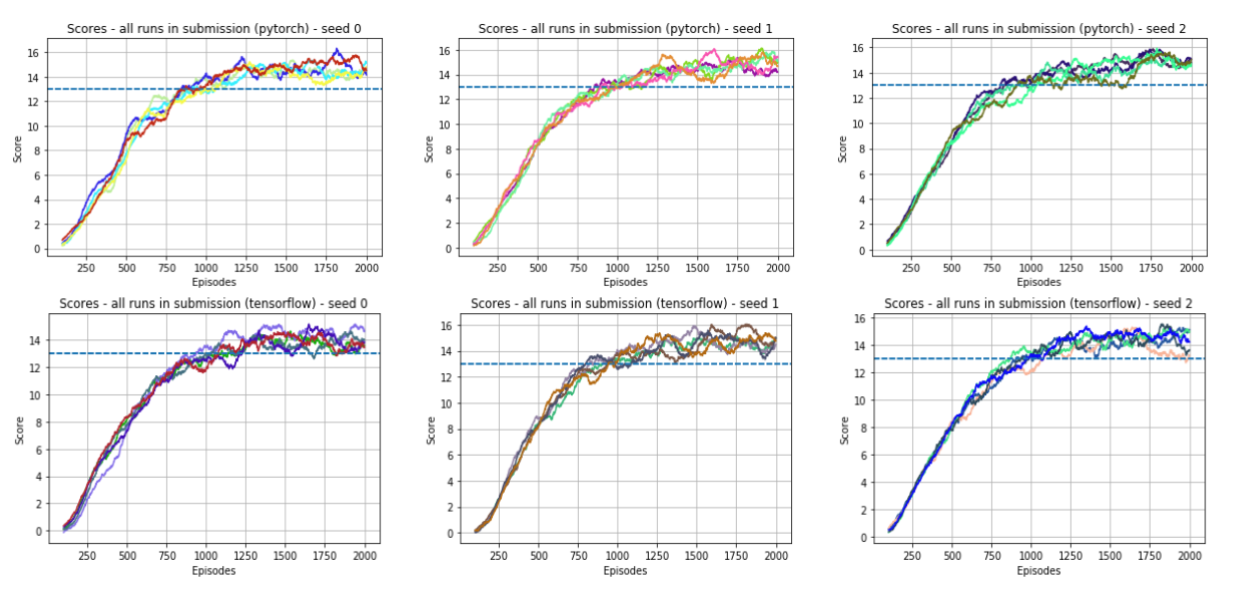
- Std-plots: Finally, we show the previous plots in the form of std-plots, which try to give a sense of the deviation of the various runs. We collected 5 runs per seed, and each std-plot is given for a specific seed. Recall again that all runs correspond to the same set of hyperparameters given by the config_submission.json file.
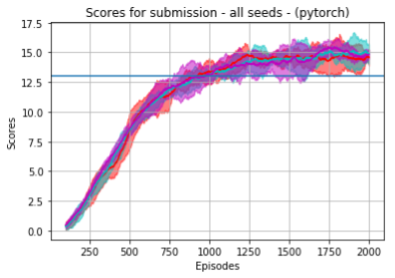
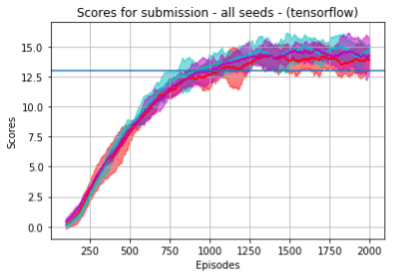
6.2 Experiment 1: tweaking exploration
In this experiment we tried to double-check if decreasing the amount of exploration would allow the agent to solve the task in fewer episodes. Because the amount of exploration is small, the agent would be forced to start trusting more its own estimates early on and, if the setup is right (big enough replay buffer, etc.), this might have the effect of making the agent solve the task quickly. The configurations used are the following:
config_agent_1_1.json : This configuration has a moderate exploration schedule. We decay \( \epsilon \) from 1.0 to 0.01 using a multiplicative decay factor of 0.9975 applied per episode. This schedule makes \( \epsilon \) decay from 1.0 to approx. 0.1 over 1000 episodes, and to the final value of 0.01 over approx. 1600 episodes.
config_agent_1_2.json : This configuration has a little more aggresive exploration schedule. We decay \( \epsilon \) from 1.0 to 0.01 using a multiplicative decay factor of 0.98 applied per episode. This schedule makes \( \epsilon \) decay from 1.0 to approx. 0.1 over 100 episodes, and to the final value of 0.01 over approx. 200 episodes.
Below we show the training results from 5 runs over 2 random seeds using these configurations. These plots reveal a trend which suggests that with the second configuration (less exploration) we get to solve the task faster (around 400 episodes) than the first configuration (around 900 episodes).
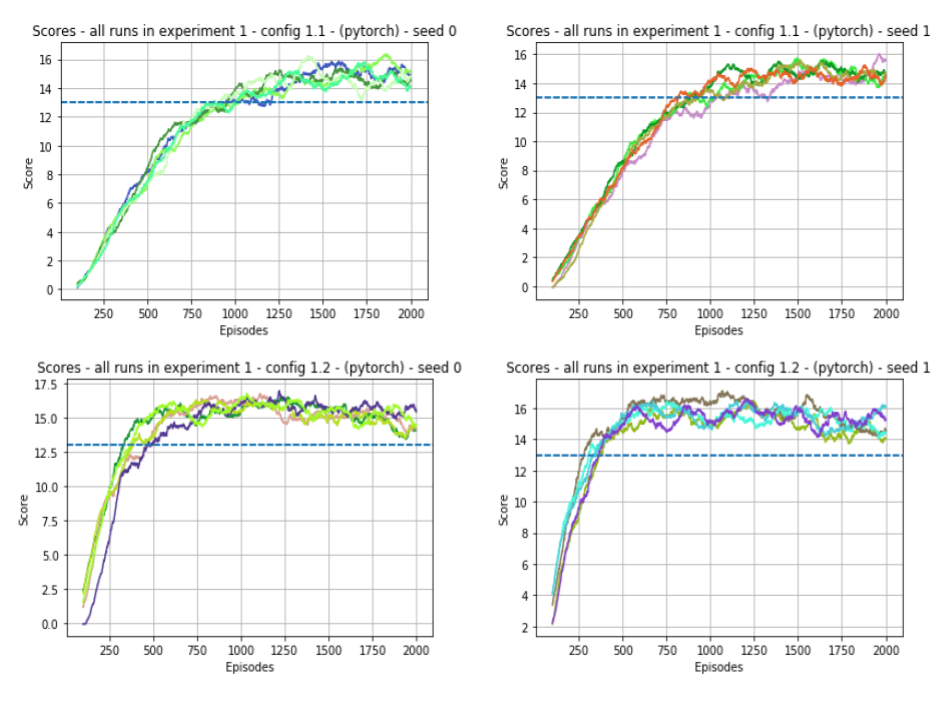
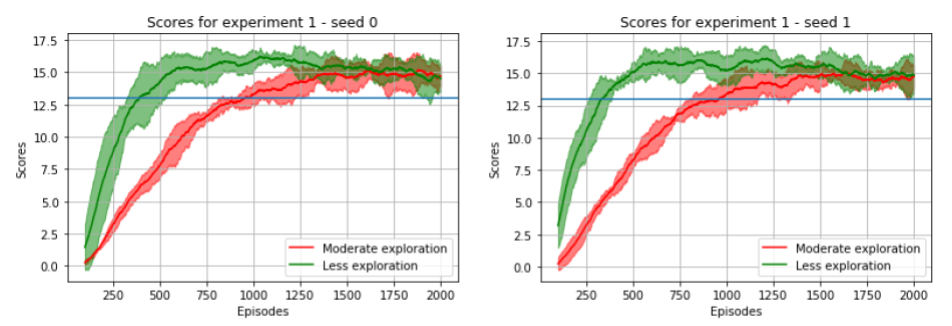
References
- [1] Sutton, Richard & Barto, Andrew. Reinforcement Learning: An introduction.
- [2] Mnih, Volodymyr & Kavukcuoglu, Koray & Silver, David, et. al.. Human-level control through deep-reinforcement learning
- [3] Achiam, Josh. Spinning Up in Deep RL
- [4] Simonini, Thomas. A Free course in Deep Reinforcement Learning from beginner to expert
- [5] Stanford RL course by Emma Brunskill
- [6] UCL RL course, by David Silver
- [7] UC Berkeley DeepRL course by Sergey Levine
- [8] Udacity DeepRL Nanodegree
- [9] DeepRL bootcamp
- [10] Van Hasselt, Hado. Double Q-learning
- [11] Van Hasselt, Hado & Guez, Arthur & Silver, David. Deep Reinforccement Learning with Double Q-learning
- [12] Schaul, Tom & Quan, John & Antonoglou, Ioannis & Silver, David. Prioritized Experience Replay
- [13] Hacker Earth. Segment Trees data structures
- [14] OpenAI. Baselines
- [15] Hessel, Matteo & Modayil, Joseph & van Hasselt, Hado & Schaul, Tom & Ostrovski, Georg & Dabney, Will & Horgan, Dan & Piot, Bilal & Azar, Mohammad & Silver, David Rainbow
- [16] Hausknecht, Matthew & Stone, Peter Deep Recurrent Q-Learning with Partially Observable MDPs